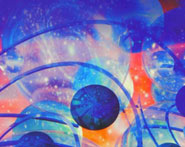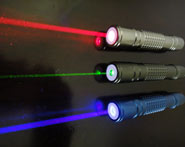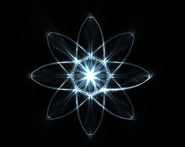


 الفيزياء الكلاسيكية
الفيزياء الكلاسيكية
 الكهربائية والمغناطيسية
الكهربائية والمغناطيسية
 علم البصريات
علم البصريات
 الفيزياء الحديثة
الفيزياء الحديثة
 النظرية النسبية
النظرية النسبية
 الفيزياء النووية
الفيزياء النووية
 فيزياء الحالة الصلبة
فيزياء الحالة الصلبة
 الليزر
الليزر
 علم الفلك
علم الفلك
 المجموعة الشمسية
المجموعة الشمسية
 الطاقة البديلة
الطاقة البديلة
 الفيزياء والعلوم الأخرى
الفيزياء والعلوم الأخرى
 مواضيع عامة في الفيزياء
مواضيع عامة في الفيزياء|
Read More
Date: 8-3-2016
Date: 8-3-2016
Date: 14-7-2020
|
Atomic Spectra
Our main application of the diffraction grating will be to study the spectrum of light emitted by atoms. It has long been known that if you have a gas of a particular kind of atom, like nitrogen, oxygen, helium, or hydrogen, a special kind of light is emitted. You do not get the continuous blend of wavelengths seen in white light. Instead the light consists of a mixture of distinct wavelengths. Which wavelengths are involved depends upon the kind of atom emitting the light. The mixture of wavelengths provide a unique signature of that atom, better than a fingerprint, for identifying the presence of an atom in a gas. In fact, the element helium (named after the Greek word helios for sun) was first identified in the sun by a study of the spectrum of light from the sun. Only later was helium found here on earth.
The subject of modern astronomy is based on the study of the spectrum of light emitted by stars. Some stars consist mostly of hydrogen gas, others a mixture of hydrogen and helium, while still others contain various amounts of heavier elements. We learn the composition of the star by studying the spectrum of light emitted, and from the composition we can deduce something about the age of the star and the environment in which it was formed.
Our main reason for studying the spectrum of light emitted by atoms will be to learn something about the atoms themselves. Since Rutherford's discovery of the atomic nucleus in 1912, it has been known that atoms consist of a positively charged nucleus surrounded by negatively charged electrons. If we apply Newtonian mechanics to predict the motion of the electrons, and Maxwell's equations to predict the kind of electromagnetic radiation the moving electrons should radiate, we get the wrong answer. There is no way that we can explain the spectrum of light emitted by atoms from Maxwell's equations and Newtonian mechanics. The existence of detailed atomic spectra is a clue that something is wrong with this classical picture of the atom. It is also the evidence upon which to test new theories.
We do not have to study many kinds of atoms to find something wrong with the predictions of classical theory. The simplest of all atoms, the hydrogen atom consisting of one proton for a nucleus, surrounded by one electron, is all we need. Heated hydrogen gas emits a distinct, orderly, spectrum of light that provides the essential clues of what is going on inside a hydrogen atom. In this chapter we will focus on using a diffraction grating to learn what the spectrum of hydrogen is. In the following chapters we use the hydrogen spectrum to study the atom itself.



|
|
|
|
التوتر والسرطان.. علماء يحذرون من "صلة خطيرة"
|
|
|
|
|
|
|
مرآة السيارة: مدى دقة عكسها للصورة الصحيحة
|
|
|
|
|
|
|
نحو شراكة وطنية متكاملة.. الأمين العام للعتبة الحسينية يبحث مع وكيل وزارة الخارجية آفاق التعاون المؤسسي
|
|
|